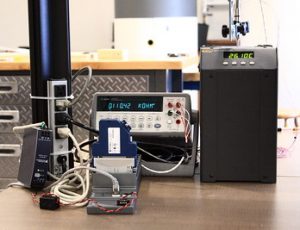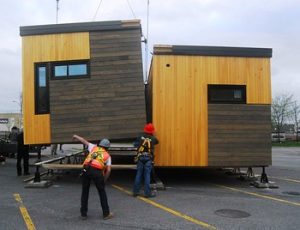The Centre for Advanced Building Envelope Research
The Centre for Advanced Building Envelope Research (CABER) seeks to improve building efficiency and resiliency by focusing on the relationship between a building’s envelope and various forms of energy loss.
In Canada, residential and commercial buildings direct most of their energy use toward the heating and cooling of indoor space, contributing greatly to the overall greenhouse gas emissions released per year. To improve the performance efficiency of building envelopes, CABER strives to reduce emissions by optimizing all the elements of a buildings envelop that separates the climate-controlled indoors and the uncontrolled outdoor climate.
Drawing upon advances in super-thin insulation materials, prefabricated construction, and panelized retrofits, CABER is developing innovative approaches for building envelopes that are thinner and more cost-effective. Additionally, CABER is pioneering new methods for renovating existing buildings with minimal cost and disruption. These efforts are crucial in helping Canada achieve its climate change goals.
CABER researchers have established a materials characterization lab and developed new experimental infrastructures capable of testing full-scale residential building facades. These advanced infrastructures enable researchers to study the movement of heat, air and moisture through building materials and highly insulated wall systems. The research focuses on understanding how these elements impact occupant health, comfort and building science risks, such as condensation, mold growth and rot.
In partnership with Algonquin College, CABER’s research will create innovative opportunities for Canada’s manufacturing, construction and renovation industries. This collaboration aims to provide new technical solutions to reduce heat loss in buildings and lower the cost associated with net zero ready and deep energy retrofit construction.
Under the supervision of Dr. Cruickshank, the Solar Energy Systems Laboratory (SESL) provides training for graduate students in both fundamental and applied research focused on developing and optimizing new solar energy technologies for the heating and cooling of buildings. SESL collaborates with other labs to the improve the efficiency and performance of residential and commercial buildings. To learn more about these projects, click here.
Both CABER and SESL are part of the Building Performance Research Centre (BPRC) at Carleton University, which is comprised of members from the CHEeR House and Human-Building Interaction Lab. BPRC seeks to advance building community design and operations, focusing on reducing energy consumption and greenhouse gas emissions while improving comfort and usability.






